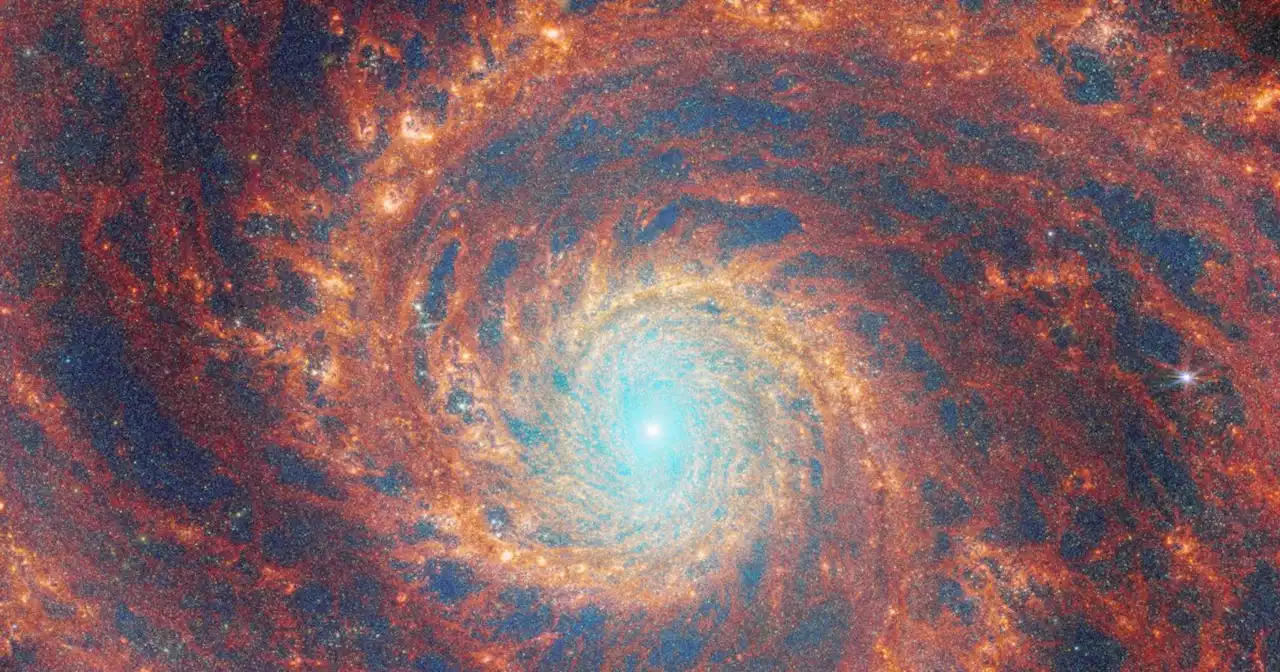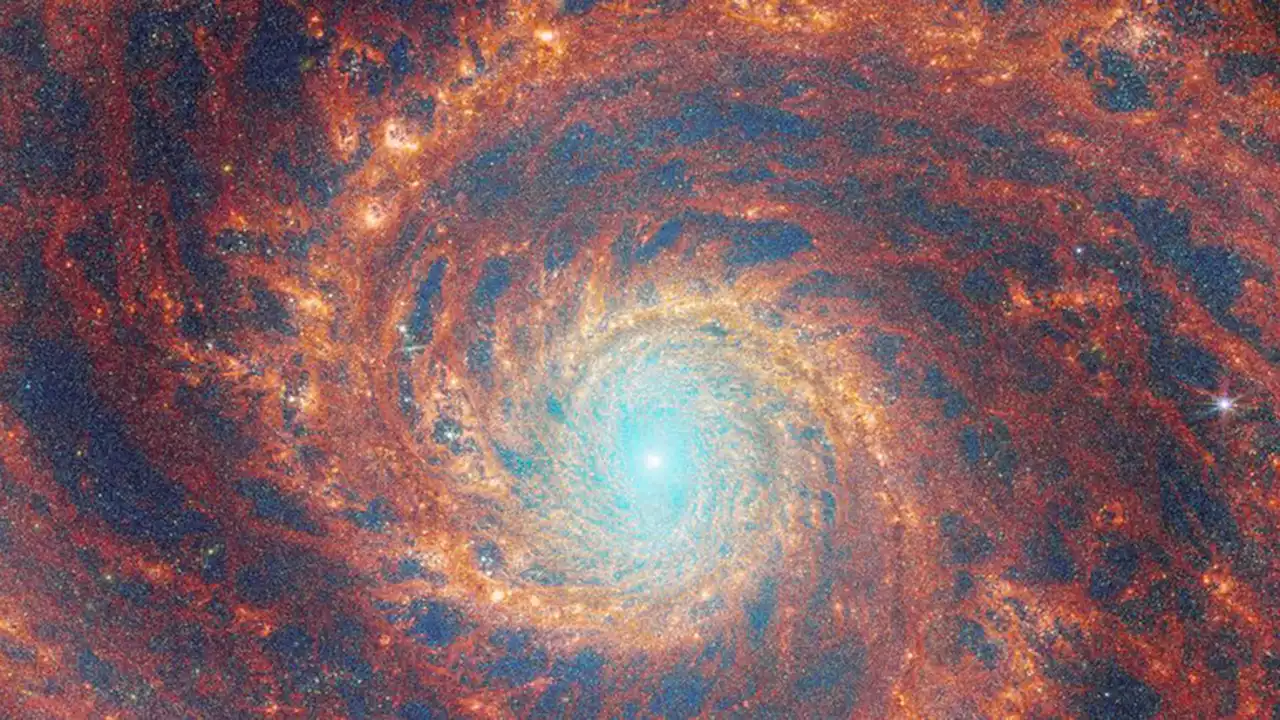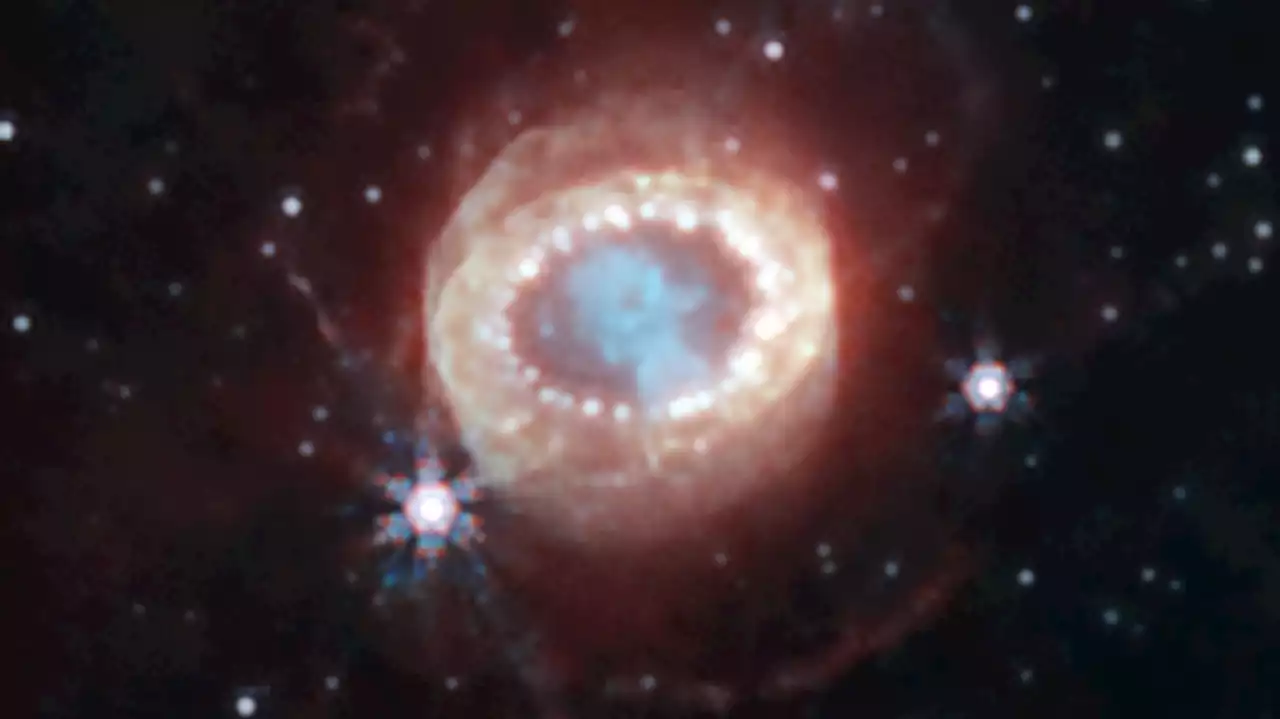NASA's James Webb Space Telescope has begun the study of one of the most renowned supernovae, SN 1987A (Supernova 1987A). Located 168,000 light-years away in the Large Magellanic Cloud, SN 1987A has been a target of intense observations at wavelengths ranging from gamma rays to radio for nearly 40 years, since its discovery in February of 1987. New observations by Webb's NIRCam (Near-Infrared Camera) provide a crucial clue to our understanding of how a supernova develops over time to shape its remnant.
This image reveals a central structure like a keyhole. This center is packed with clumpy gas and dust ejected by the supernova explosion. The dust is so dense that even near-infrared light that Webb detects can't penetrate it, shaping the dark"hole" in the keyhole.
A bright, equatorial ring surrounds the inner keyhole, forming a band around the waist that connects two faint arms of hourglass-shaped outer rings. The equatorial ring, formed from material ejected tens of thousands of years before the supernova explosion, contains bright hot spots, which appeared as the supernova's shock wave hit the ring. Now spots are found even exterior to the ring, with diffuse emission surrounding it.
While these structures have been observed to varying degrees by NASA's Hubble and Spitzer Space Telescopes and Chandra X-ray Observatory, the unparalleled sensitivity and spatial resolution of Webb revealed a new feature in this supernova remnant -- small crescent-like structures. These crescents are thought to be a part of the outer layers of gas shot out from the supernova explosion.
The high resolution of these images is also noteworthy. Before Webb, the now-retired Spitzer telescope observed this supernova in infrared throughout its entire lifespan, yielding key data about how its emissions evolved over time. However, it was never able to observe the supernova with such clarity and detail.
Despite the decades of study since the supernova's initial discovery, there are several mysteries that remain, particularly surrounding the neutron star that should have been formed in the aftermath of the supernova explosion. Like Spitzer, Webb will continue to observe the supernova over time. Its NIRSpec and MIRI instruments will offer astronomers the ability to capture new, high-fidelity infrared data over time and gain new insights into the newly identified crescent structures.
Australia Latest News, Australia Headlines
Similar News:You can also read news stories similar to this one that we have collected from other news sources.
 James Webb Space Telescope captures stunning images of the Ring Nebula -- ScienceDailyNASA's James Webb Space Telescope has recorded breath-taking new images of the iconic Ring Nebula, also known as Messier 57.
James Webb Space Telescope captures stunning images of the Ring Nebula -- ScienceDailyNASA's James Webb Space Telescope has recorded breath-taking new images of the iconic Ring Nebula, also known as Messier 57.
Read more »
 James Webb captures the magnificent Whirlpool GalaxyA new image from the James Webb Space Telescope shows the Whirlpool Galaxy, a galaxy so picturesque it is designated a grand-design spiral galaxy.
James Webb captures the magnificent Whirlpool GalaxyA new image from the James Webb Space Telescope shows the Whirlpool Galaxy, a galaxy so picturesque it is designated a grand-design spiral galaxy.
Read more »
 James Webb captures hypnotic photos of the Whirlpool spiral galaxyA new image from the James Webb space telescope gives us a beautiful look at the Whirlpool Galaxy and its unique spiral arms.
James Webb captures hypnotic photos of the Whirlpool spiral galaxyA new image from the James Webb space telescope gives us a beautiful look at the Whirlpool Galaxy and its unique spiral arms.
Read more »
![]() Iconic supernova captured by the James Webb Space TelescopeThe supernova 1987A lies around 168,000 light years from Earth, and is the closest stellar explosion we have seen in hundreds of years. Now, the James Webb Space Telescope is revealing new details
Iconic supernova captured by the James Webb Space TelescopeThe supernova 1987A lies around 168,000 light years from Earth, and is the closest stellar explosion we have seen in hundreds of years. Now, the James Webb Space Telescope is revealing new details
Read more »
 James Webb Space Telescope snaps stunning view of supernova's expanding remains (photos)This supernova, the brightest in the past 420 years, signaled the explosive death of a supergiant star in the Large Magellanic Cloud.
James Webb Space Telescope snaps stunning view of supernova's expanding remains (photos)This supernova, the brightest in the past 420 years, signaled the explosive death of a supergiant star in the Large Magellanic Cloud.
Read more »
